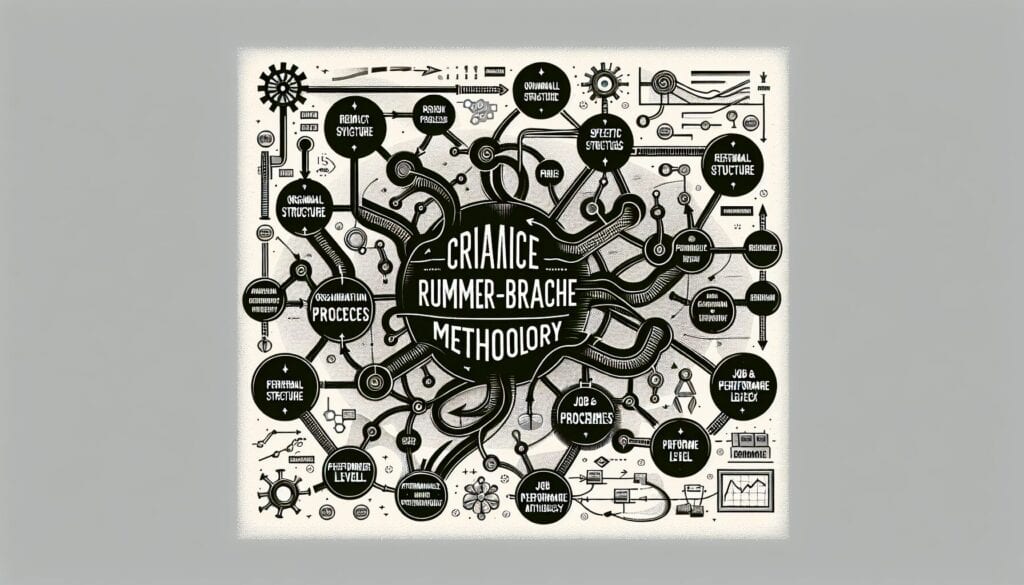A performance improvement methodology that focuses on viewing an organization as an adaptive system and managing performance at three levels: organizational, process, and job/performer.
- Methodologies: Customers & Marketing, Ideation, Product Design
Rummler-Brache Methodology

Rummler-Brache Methodology
- Agile Methodology, Business Process Reengineering (BPR), Change Management, Continuous Improvement, Lean Manufacturing, Organizational Transformation, Performance Tracking, Process Mapping, Quality Management
Objective:
How it’s used:
- Emphasizes understanding the "white space" between functional silos where processes often break down. Uses tools like process mapping and Human Performance System analysis to diagnose and improve performance.
Pros
- Provides a comprehensive framework for performance improvement; links strategy, processes, and individual performance; helps identify and address systemic issues.
Cons
- Can be complex to implement fully; requires a systems thinking approach throughout the organization; may require significant training and cultural change.
Categories:
- Human Resources, Project Management, Quality
Best for:
- Improving organizational performance by systematically analyzing and aligning goals, processes, and individual job performance across the entire organization.
The Rummler-Brache Methodology is particularly effective in industries such as healthcare, manufacturing, finance, and technology, where process efficiency is pivotal for organizational success. During the planning and execution phases of projects, this methodology can be initiated by executives or operations managers looking to enhance alignment between strategic objectives and day-to-day operations. Participants generally include cross-functional teams composed of stakeholders from different areas of the organization, as it promotes collaboration and communication among various departments. Tools used in this methodology, such as process mapping, allow for visual representation of workflows, making it easier to identify bottlenecks and areas for improvement. Human Performance System analysis further aids in diagnosing problems by examining how individual behaviors impact overall performance. This systematic approach not only targets existing issues but also ensures that future initiatives are aligned with the organization’s long-term goals. The framework supports continuous improvement efforts, fostering a culture where feedback is integrated into performance reviews and project evaluations, thus encouraging adaptive strategies that can be implemented in real-time. As such, organizations employing this methodology often report enhanced employee engagement and accountability, as individuals understand how their performance directly influences organizational success.
Key steps of this methodology
- Identify the organizational goals and objectives.
- Map current processes across functional silos.
- Analyze the "white space" between processes for performance breakdowns.
- Assess individual job performance related to processes.
- Identify systemic issues affecting organizational performance.
- Develop interventions targeting the identified issues.
- Implement process improvements and training initiatives.
- Monitor performance changes and adjust as necessary.
Pro Tips
- Conduct regular cross-functional reviews to surface hidden inefficiencies and align goals across silos.
- Utilize data analytics to identify performance gaps and quantify the impact of process changes on outcomes.
- Develop a culture of continuous feedback and open communication to mitigate resistance to change and enhance collaboration.
To read and compare several methodologies, we recommend the
> Extensive Methodologies Repository <
together with the 400+ other methodologies.
Your comments on this methodology or additional info are welcome on the comment section below ↓ , so as any engineering-related ideas or links.
Historical Context
1962
1970
1972
1980
1980
1986
1986
1960
1963
1970
1980
1980
1980
1986
1987
(if date is unknown or not relevant, e.g. "fluid mechanics", a rounded estimation of its notable emergence is provided)















Related Posts
Musculoskeletal Discomfort Questionnaires
Multivariate Testing (MVT)
Multiple Regression Analysis
Motion Capture Systems
MoSCoW Method
Mood’s Median Test